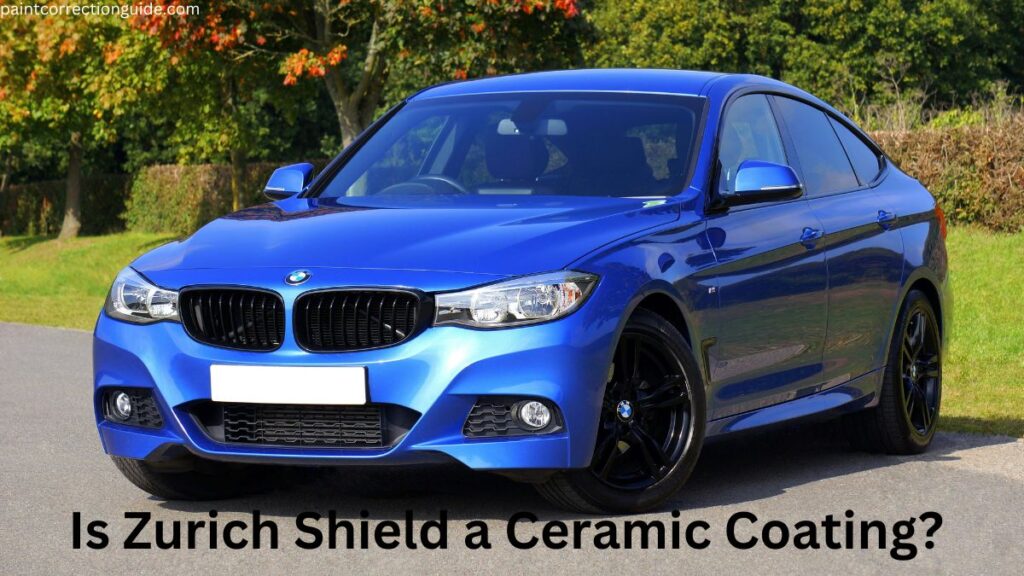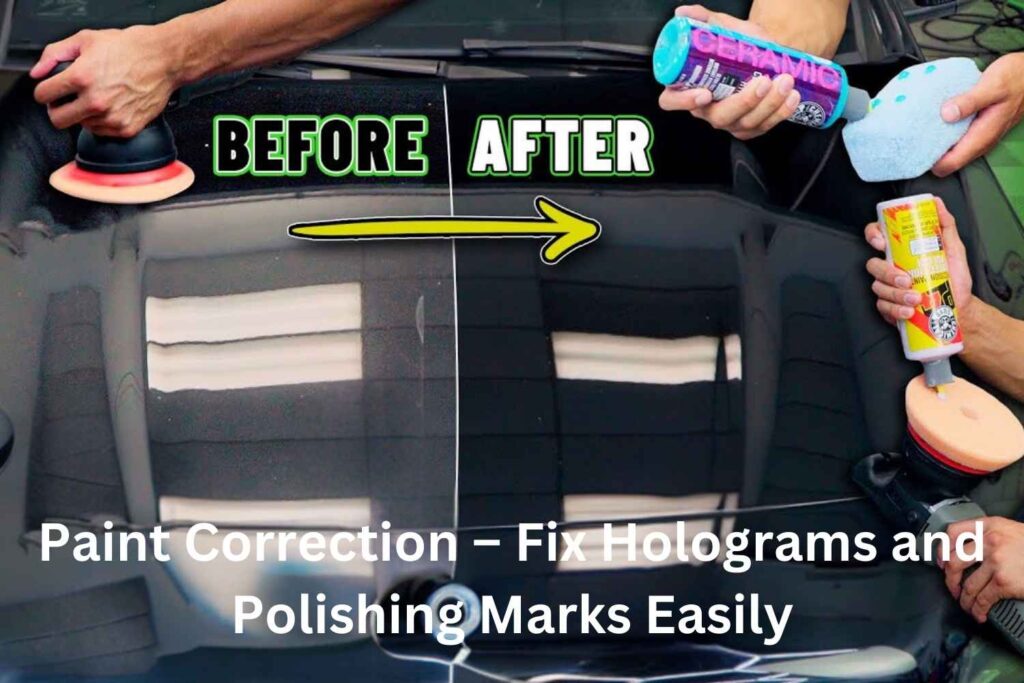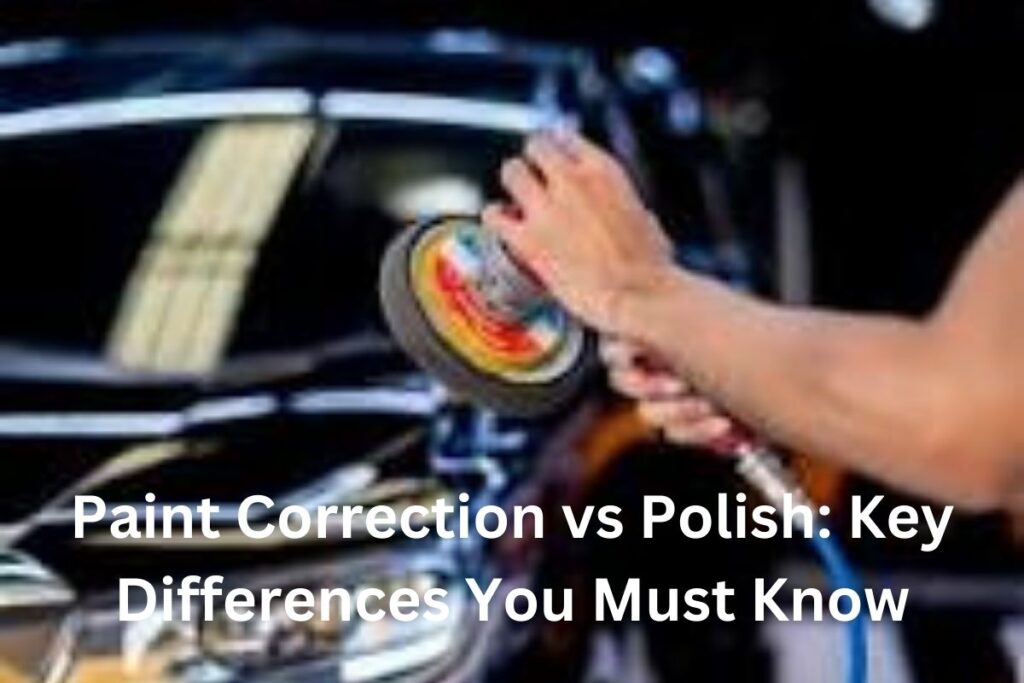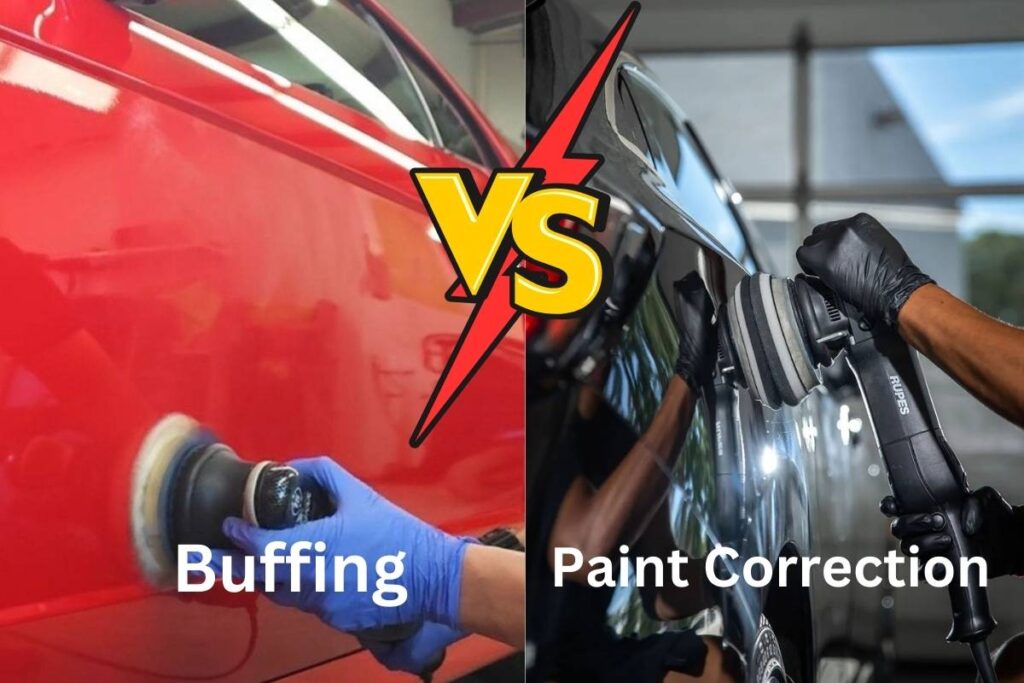What is the difference between paint correction vs polish? Many people confuse these two car detailing terms. While both improve the look of your car’s paint, they do very different things. One repairs flaws like scratches and swirl marks. The other enhances shine and prepares the surface for protection.
Understanding the difference helps you make the right choice for your car. It saves time, money, and ensures the best results. This blog will explain each process in simple terms. By the end, you will know which one your car needs and why. Let’s get started!
Table of Contents
ToggleWhat is Paint Correction?

Paint correction is a process that fixes defects in the paint of a car. These defects include scratches, swirl marks, water spots, and oxidation. It restores the paint to its original, smooth condition.
This process removes a thin layer of the clear coat. The clear coat is the top layer of the car’s paint. It protects the color underneath. By removing this thin layer, imperfections disappear, and the paint looks fresh again.
Professional detailers use tools like rotary buffers and dual-action polishers. They also use special compounds and pads to work on the surface. Each tool and product plays a role in removing defects without damaging the paint.
Paint correction has different levels. A light correction fixes minor swirl marks. A deeper correction removes heavier scratches or damage. The level depends on the condition of the car’s paint.
The result is a flawless, mirror-like finish. This process is ideal for cars with visible defects or dull paint. It makes the car look new again.
What is Polish in Car Detailing?

Polish improves the appearance of car paint. It smooths the surface and removes minor imperfections. These imperfections include light scratches, haze, and small swirl marks. Polish is not as aggressive as paint correction.
Polishing makes the paint shiny and prepares it for protective layers. This includes wax or sealant. Without polishing, wax may not bond well to the surface. The result might not last long.
Detailers use different types of polishes. Some have fine abrasives to remove small imperfections. Others are non-abrasive and only enhance the shine. The type of polish depends on the condition of the car’s paint.
Tools like polishers or buffing pads help apply the product evenly. For smaller areas, hand polishing works. Machine polishing is faster and more effective for larger surfaces.
Polish does not fix deep scratches or major defects. It focuses on improving the overall look of the paint. This process is best for cars with minor imperfections or dull surfaces.
Paint Correction vs Polish: Key Differences
Purpose
- Paint Correction:
- Definition: Paint correction involves the mechanical leveling of a car’s paint or clear coat to remove imperfections such as scratches, swirl marks, oxidation, and other defects.
- Outcome: The goal is to achieve a flawless, mirror-like finish by eliminating defects rather than merely concealing them.
- Polishing:
- Definition: Polishing uses a gently abrasive liquid to clean, smooth, and enhance the shine of a car’s paint.
- Outcome: It aims to improve the surface gloss and prepare the paint for protective layers like wax or sealant, addressing minor imperfections but not deep defects.
Depth of Work
- Paint Correction:
- Process: Involves removing a thin layer of the clear coat to level the surface, effectively eliminating deeper imperfections.
- Stages:
- Stage 1: Addresses light imperfections with a single polishing step.
- Stage 2: Targets moderate defects using two polishing steps with different compounds.
- Stage 3: Involves multiple polishing stages, including potential wet sanding, for severe defects.
- Polishing:
- Process: Focuses on the surface layer, utilizing finer abrasives to enhance gloss and remove light imperfections without significantly altering the clear coat.
Tools and Techniques
- Paint Correction:
- Equipment: Utilizes rotary buffers, dual-action polishers, and a range of compounds from heavy-cutting to fine polishes.
- Techniques: May involve multiple stages, including wet sanding for severe defects, requiring advanced skill to avoid paint damage.
- Polishing:
- Equipment: Employs dual-action or orbital polishers, buffing pads, and polishing compounds with fine abrasives.
- Techniques: Generally involves a single-stage process aimed at enhancing gloss and preparing the surface for protection.
Time and Cost
- Paint Correction:
- Time Investment: Can range from several hours to multiple days, depending on the severity of defects and the level of correction desired.
- Cost: Higher due to the intensive labor, expertise required, and the use of specialized equipment and products.
- Polishing:
- Time Investment: Typically completed within a few hours, as it addresses only surface-level imperfections.
- Cost: More affordable, reflecting the less intensive nature of the process.
When to Use Each
- Paint Correction:
- Ideal For: Vehicles with significant paint defects, including deep scratches, heavy swirl marks, oxidation, and other noticeable imperfections.
- Considerations: Best suited for older vehicles, neglected paint surfaces, or car enthusiasts seeking a showroom-quality finish.
- Polishing:
- Ideal For: Vehicles with minor surface imperfections, dull paint, or as a preparatory step before applying a protective layer.
- Considerations: Suitable for regular maintenance, newer cars, or as part of routine detailing to maintain paint clarity and gloss.
When to Choose Paint Correction vs Polish
Use Paint Correction for Visible Defects
Paint correction works best for cars with noticeable defects. These defects include deep scratches, swirl marks, water spots, and faded paint. Cars with years of wear and exposure to harsh elements benefit the most.
Vehicles with heavy use often develop paint imperfections. Road debris, bad washing techniques, and sun damage cause these problems. Paint correction removes these flaws and restores the car’s original look.
Use Polish for Light Imperfections
Polish is ideal for cars with minor paint issues. These include light scratches, haze, or dull surfaces. Cars with good overall paint condition only need polishing to enhance shine.
Polish also works as a preparation step. It cleans the surface and removes small imperfections. This makes it easier for wax or sealant to bond. Without polish, the final result may not last long.
Match the Process to Your Car’s Condition
Cars with heavy scratches and oxidation need paint correction. The process is more detailed and provides a dramatic transformation. Older cars or neglected paint often require this step.
Newer cars or cars with mild imperfections can use polish. It improves the shine and keeps the paint looking fresh. Vehicles with regular maintenance often only need this simpler process.
Consider the Cost and Time
Paint correction is more expensive. It takes longer because it fixes deeper issues. The tools and products used in paint correction are also more specialized.
Polish costs less and takes less time. It is a simpler process and does not require the same level of expertise.
Think About Long-Term Results
Paint correction provides lasting results. Once the imperfections are removed, the paint stays flawless for a long time. Regular maintenance helps keep the finish intact.
Polish gives short-term improvement. It does not fix deep issues, so the results are temporary. Cars that only need a surface shine benefit most from polish.
Recommended Products and Tools for Paint Correction vs Polish
Tools for Paint Correction
Paint correction needs specialized tools. These tools remove defects and restore the paint. Rotary buffers and dual-action polishers are common. Rotary buffers are powerful. They remove deep scratches and oxidation. Dual-action polishers are safer and better for beginners.
Detailers use cutting compounds with these tools. Compounds have abrasives that level the surface. This removes imperfections like swirl marks. Foam or microfiber pads attach to the polisher. These pads spread the compound evenly and prevent damage.
Paint thickness gauges are helpful. They measure the clear coat thickness before starting. This prevents removing too much paint and causing harm.
Tools for Polish
Polish needs simpler tools. Polishing machines or buffing pads work well. Dual-action polishers are also popular for this process. They spread polish evenly and enhance the surface. Hand polishing is another option. It is slower but works for small areas.
Different types of polish are available. Some have fine abrasives to remove light scratches. Non-abrasive polishes focus on improving shine. Detailers pick the product based on the car’s condition.
Popular Products for Paint Correction
- Meguiar’s M105 Ultra-Cut Compound: Removes heavy defects and scratches. Works well with rotary and dual-action polishers.
- 3D One Hybrid Compound: A versatile product for cutting and polishing. Ideal for different stages of paint correction.
- Chemical Guys V32 Compound: Removes severe imperfections like oxidation and deep scratches.
Popular Products for Polish
- Meguiar’s Ultimate Polish: Enhances gloss and removes minor imperfections. Works with both machine and hand application.
- Griot’s Garage Complete Polish: A mild polish for surface enhancement. Perfect for prepping the paint before waxing.
- Sonax Perfect Finish: Removes fine scratches while improving shine. Great for new or well-maintained paint.
Tips for Choosing the Right Tools and Products
Pick tools based on your experience level. Rotary buffers are effective but require skill. Beginners should use dual-action polishers for safety. Select products based on your car’s needs. Heavy compounds are for deep scratches. Light polishes work for surface enhancement.
Always use high-quality pads and machines. This prevents uneven results and damage. Test a small area before starting to ensure the product works as expected.
DIY vs Professional Services
Benefits of Professional Paint Correction
Comprehensive Services: Professionals offer services beyond what typical DIYers can easily perform at home, such as engine detailing, paint correction, and applying ceramic coatings. These services require precise techniques and conditions to be executed correctly, ensuring a higher quality finish.
Advanced Techniques and Equipment: Professional detailers utilize specialized tools and products that are often inaccessible to the average consumer. This includes high-powered washers, specialized chemicals, and advanced techniques like clay barring and high-speed polishing, which can dramatically improve the vehicle’s appearance and provide superior protection.
Risks of DIY Paint Correction
Time and Effort: DIY paint correction is time-consuming and requires significant effort. Achieving a professional-level finish demands meticulous attention to detail, which can be overwhelming for individuals without sufficient experience.
Potential for Damage: Without proper knowledge and experience, DIY paint correction can lead to mistakes that may damage your vehicle, such as using the wrong cleaning products or improper techniques. These errors can result in uneven finishes, swirl marks, or even removal of too much clear coat, causing permanent harm.
Benefits of DIY Polishing
Flexibility and Control: Handling the detailing process yourself provides complete autonomy to control every aspect of the process. Whether it’s selecting preferred products, determining the pace of work, or customizing cleaning methods according to specific preferences, it offers a hands-on experience that many find rewarding.
Cost-Effective: DIY polishing can be a rewarding and economical option if one enjoys cleaning and maintaining a vehicle and has the time and space to do it properly. It allows for a personal connection with the vehicle and can be a satisfying hobby.
When to Choose Professional Help
Specialized Services: Professionals often provide services beyond what typical DIYers can easily do at home, such as engine detailing, paint correction, and applying ceramic coatings. These services require precise techniques and conditions to be done correctly.
Complex Procedures: Professional services are best for heavy damage or neglected paint. Older cars with deep scratches or severe oxidation need expert care. People with limited time or no experience benefit from hiring detailers.
When DIY Works Best
Personal Satisfaction: Engaging in DIY auto detailing can be an inherently rewarding experience, offering a sense of personal satisfaction and accomplishment. There’s something fulfilling about taking care of your own vehicle, gaining intimate knowledge of its maintenance needs, and witnessing the tangible results of your efforts.
Routine Maintenance: DIY works well for minor imperfections and surface enhancement. Newer cars with light scratches or dull paint only need basic polishing. This saves money and helps maintain the car’s appearance.
Cost Comparison
DIY Approach: DIY polishing costs much less. Most polishing kits cost under $100. The results may not match professional services, but they work for small improvements.
Professional Services: Professional paint correction is expensive. It ranges from hundreds to thousands of dollars. The cost depends on the level of correction and the size of the car.
Maintaining Results After Paint Correction or Polishing
Maintaining your vehicle’s pristine finish after paint correction or polishing is essential for long-term protection and shine. Building upon your existing guidelines, here are additional insights to enhance your maintenance routine:
Use Wax or Sealant
- Selection: Choose high-quality products tailored to your needs. Natural carnauba waxes offer a deep, warm glow, ideal for show cars, while synthetic sealants provide longer-lasting protection, making them suitable for daily drivers.
- Application Conditions: Apply wax or sealant in a shaded, dust-free environment to prevent premature drying and contamination. Ensure the vehicle’s surface is cool to the touch to facilitate even application.
- Layering: While layering multiple coats can enhance protection, it’s crucial to follow the manufacturer’s recommendations to avoid issues like streaking or hazing.
Wash the Car Properly
- Frequency: Regular washing is vital to remove contaminants that can degrade the paint. Aim to wash your vehicle every two weeks, adjusting based on environmental factors and usage.
- Drying Technique: After washing, use a soft microfiber drying towel to gently pat the surface dry, minimizing the risk of introducing swirl marks. Avoid air drying, as it can lead to water spots.
Avoid Rough Materials
- Maintenance of Tools: Regularly inspect and clean your microfiber towels and wash mitts. Debris trapped in the fibers can cause scratches during use. Replace any tools that show signs of wear or contamination.
Park in Safe Places
- Environmental Considerations: In addition to UV rays, be mindful of industrial fallout and airborne contaminants in urban areas. Parking away from factories or construction sites can help preserve your vehicle’s finish.
Apply Ceramic Coating (Optional)
- Preparation: Before application, ensure the paint surface is meticulously clean and free from any oils or residues. This may involve steps like clay bar treatment and the use of isopropyl alcohol wipes to promote optimal bonding.
- Curing Time: After application, allow the coating to cure as per the manufacturer’s instructions, which may range from a few hours to several days. During this period, keep the vehicle dry and avoid unnecessary handling.
- Maintenance: Even with a ceramic coating, regular maintenance is essential. Use pH-neutral shampoos for washing and avoid abrasive cleaners that can diminish the coating’s effectiveness.
For a visual guide on applying ceramic coating, you might find this video helpful:
Inspect Regularly
- Seasonal Checks: Conduct thorough inspections at the change of each season, as varying weather conditions can introduce different challenges to your vehicle’s finish.
- Professional Assessment: Consider scheduling periodic evaluations with a professional detailer to assess the condition of your vehicle’s paint and receive expert maintenance advice.
By integrating these practices into your car care routine, you can significantly extend the longevity of your vehicle’s finish, ensuring it remains vibrant and protected for years to come.
Conclusion
Paint correction and polishing are two important processes in car detailing. Each has its own purpose and benefits. Understanding the difference helps you decide what your car needs.
Paint correction removes defects like scratches, swirl marks, and oxidation. It restores the paint to its original condition. This process is perfect for older cars or vehicles with visible damage.
Polishing improves the surface shine. It removes light scratches and haze. It also prepares the paint for wax or sealant. Polishing works well for newer cars or cars with minor imperfections.
Both processes can make your car look better. Paint correction takes more time, tools, and skill. Polishing is easier and faster. For deep defects, hire a professional for paint correction. For minor issues, polishing is a simple and affordable option.
Regular maintenance keeps the results longer. Use wax or sealant to protect the paint. Wash the car carefully to avoid scratches. Inspect the paint often and fix small problems early.
Taking care of your car’s paint keeps it looking great. It also protects your car’s value. Whether you need paint correction or polishing, both are worth the effort.
Frequently Asked Questions (FAQs)
How often should I perform paint correction on my car?
Perform paint correction only when necessary, such as when visible defects like scratches or swirl marks appear. Overuse can thin the clear coat. Regular maintenance reduces the need for frequent correction.
Can polishing remove all scratches from my car’s paint?
Polishing removes light scratches and swirl marks. Deeper scratches may require paint correction or professional repair. Assess the scratch depth before deciding on the method.
Is it safe to perform paint correction or polishing at home?
DIY polishing is generally safe for minor imperfections. Paint correction requires skill and proper tools; mistakes can damage the paint. Consider professional help for significant defects.
How long do the results of paint correction and polishing last?
The longevity depends on maintenance and environmental factors. With proper care, paint correction results can last several years. Polishing effects may last a few months.
What is the cost difference between paint correction and polishing?
Paint correction is more expensive due to its intensive process, often ranging from hundreds to thousands of dollars. Polishing is less costly, typically under $100 for DIY kits or more for professional services.







